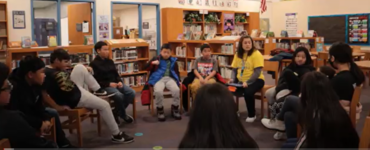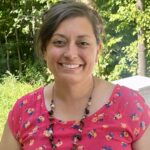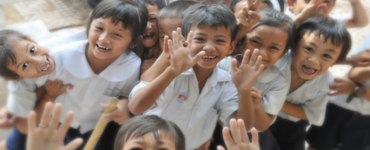This study shares findings that show how an equity-driven elementary afterschool program for multilingual learners supports community building and social emotional wellbeing.
Keywords: afterschool, multilingual learners, equity, social and emotional learning
Afterschool programs offer important opportunities for students to build community and create spaces for them to grow and learn in ways that go beyond what is possible during the school day. Multilingual learners (MLs), however, are often either left out of these programs or underserved by them. Programming in afterschool settings seldom includes spaces for home languages of students and often fails to be culturally and linguistically sustaining for the diverse students it serves (Gast et al., 2017). In this article, we report on our work with elementary learners involved in an afterschool project, Global StoryBridges (GSB), that seeks to create spaces specifically for multilingual learners to develop community and flourish as learners. We focus specifically on the community that learners built locally with each other, as they communicated with peers around the world. We also share our challenges while demonstrating the need for equity-driven afterschool programming for MLs.
The findings we share in this article are part of a year-long ethnographic study of the afterschool program. Throughout the year, we worked as co-facilitators in the afterschool program and co-researchers of the project. We filmed each meeting with the youth, conducted regular group interviews with the youth, and conducted at least one formal one-on-one interview with each of the youth participating near the end of the year. To analyze the data, we used narrative analysis (De Fina & Georgakopoulou, 2012) to better understand how the youth were positioning themselves and others in their interactions during meetings and with us in interviews.
Our findings suggest that much more work is needed to create classrooms in which there is respect for refugee children; where students’ funds of knowledge are used in the curriculum (Gilhooly, 2015), and texts, materials, and activities that reflect children and their unique and complex cultural identities are incorporated. To move toward creating space for cultural pluralism in social and emotional learning development, we suggest that teachers integrate age-appropriate and culturally relevant books as a platform for deep discussions about social and emotional norms (i.e., from diverse cultural perspectives).
The possibilities: Equity and social emotional wellbeing
Social and emotional learning (SEL) may be referenced by various terms such as character education, 21st-century skills, or soft skills (Jones & Doolittle, 2017).
In their article, Benavides et al. (2020) note that SEL can have a profound impact on equity efforts: “It can enhance academic, emotional, social, and career wellness—areas of youth and human development that are all directly and severely affected by inequity” (p. 1).
Through teacher interviews in their study, Cho et al. (2019) share some of the key strategies that emerged in teacher’s work to support multilingual learners’ social emotional wellbeing. One of those areas includes collaboration with others and grouping students in school contexts. Teachers noted increased engagement and reduced frustration or intimidation when supported by their peers. (Cho et al., 2019, pp. 50–51). Their findings also pointed to the need for school programming to support students’ funds of knowledge (Gilhooly, 2015; González et al., 2006) and for content that reflects students’ unique and complex cultural identities. Consistent with language acquisition research, the researchers for this study point to elevating students’ strengths such as their life experiences, knowledge, and resilience and incorporate their backgrounds into the learning space.
As Jones and Doolittle (2017) note, interest in SEL has greatly increased in recent years. Drawing on work by Gregory et al. (2016), they suggest that “SEL skills could be central to understanding and remediating stubbornly persistent gaps in achievement defined by income and racial/ethnic differences” (Jones & Doolittle, 2017, p. 5).
Through the work with the Global StoryBridges project, we examined how this type of program could afford opportunities for communication and community. We also looked at how out-of-school or nontraditional educational programming could support academic objectives and social emotional competencies.
Global StoryBridges
Global StoryBridges (https://www.globalstorybridges.com/) is an educational project designed to take place in out-of-school spaces around the world. The focus of the project is on connecting learners from under-resourced communities who are learning English to share and discuss their lives. Learners are in upper-elementary school (aged 10–12 years old). At the sites, volunteer facilitators help guide youth to work collaboratively to create videos about their lives, which they then upload to the project website. Youth at all of the sites are then able to watch and post comments on the videos, and reply to comments and questions about their own videos, enabling robust discussion of their videos and lives.
During the time period we describe in this article, our learners communicated with peers from China, Mexico, South Africa, and Uganda. Though English was the lingua franca of the project, youth translanguaged at sites as they brainstormed videos, taught others words from their home languages during videos and interactions, and occasionally sent bilingual messages (with messages between our group and the group in Mexico being in at times in Spanish and English).
Northwoods Elementary
Our site at Northwoods Elementary (all names are pseudonyms) was situated in a metro area in the upper Midwest of around 160,000 people. The region has become home to immigrant and refugee families over the years, beginning with the resettlement of Hmong families following the Vietnam War. Since then, it continues to boast a diverse population with its school district comprising over 30 language groups.
Northwoods Elementary is a Title I school, with just over 70% of students coming from families classified as economically disadvantaged. The school population was roughly 54% white, 15% Asian, 17% Hispanic or Latino, 5% Black, and 9% multiracial, with 14% classified as English learners.
There were 10 learners participating in GSB at our site: six in fifth grade, four in fourth, three from Mexican families, and seven from Hmong families. In this article, we focus on three learners: Isaiah, a fifth-grade student whose family came from Mexico, and Emi and Pia, fourth-grade sisters who are Hmong. We selected these three learners for this article to share perspectives from students at different age levels and from linguistic and cultural backgrounds.
Opportunities to build community – Isaiah
Isaiah is proud of his Mexican heritage and travels often back to visit extended family in Mexico, often for long periods of time. He had moved around quite a bit, attending three different schools by the time he was in fifth grade. When we worked with him, he had a history of academic and behavior challenges and missed a lot of school. He seemed to often use negative attention from teachers as a way to build his social identity.
Isaiah and another fifth grader, Carlos, relished teaching others at our site about Mexican culture and food. They often exchanged greetings with others in Spanish, and used Spanish to help interpret what the group in Mexico had written when they used Spanish to communicate with our group.
Over the year, Isaiah’s attendance improved significantly, and his behavior in class shifted. He began to seek positive attention from teachers and took on leadership roles in the school, even being selected by the principal to be a school ambassador. We interviewed him in May to understand more about what GSB had meant to him and understand more about what role it may have helped play in his transformation (see Excerpt 1; transcription conventions are included in the appendix).
Excerpt 1. What Isaiah liked about GSB.
| 1 | Gordon: | What do you like about it [GSB]? |
| 2 | Isaiah: | Just like, there’s like not so many people there and like we can do stuff after |
| 3 | school, like uh, spend time and different stuff. | |
| 4 | Gordon: | Okay. What do you usually do after school? |
| 5 | Isaiah: | I usually just go, like go outside a little bit with my friends, or I just go like play |
| 6 | video games with my friends that are not like, around here. |
In our interview with him, we learned a few important facts that helped to understand better what the afterschool program meant to him. First, Isaiah was often left with little to do after school other than play video games. He mentioned going outside with friends, but in later discussions with Sara, he clarified that he had meant that he played outside with Emi and Pia, friends he made through GSB. Prior to GSB, he had struggled to make connections at his new school. In the interview, he said that he played video games with his friends, but that those friends didn’t actually live in the town where we were. They were in the next town over, and he was able to visit them when his father was able to give him a ride.
Another important point was about the size of GSB. He said that what he liked about GSB was that there were “not so many people.” There were 10 learners participating, small enough that we were able to give more individual attention to each student, and they were also able to build stronger connections. They were all also multilingual learners, something that was often explicitly discussed as an asset in our meetings and that they had as common ground to form bonds.
What GSB meant to Emi and Pia
Emi and Pia are sisters from a large Hmong family with several older siblings. At the time of our project, they were in fourth grade. Up to that point, their family had moved around a lot, and they had missed significant amounts of school in earlier grades. When they started GSB with us, they weren’t even sure of the name of the city that they lived in.
They had arrived at the school the previous year, but due to COVID, they had spent much of the past two years attending virtually. That experience, combined with their previous moves, left them very isolated and they were eager to establish friendships with others when the new school year started, although they were both initially quite shy. We interviewed them at the end of April to learn more about their experiences with GSB. During the interview, they mentioned that one of their favorite things about GSB was getting to know fifth graders. The following excerpt picks up just after they had mentioned this and continues as they talked about their experience transitioning to the school during COVID (see Excerpt 2).
Excerpt 2. “I thought the people at school was robots.”
| 1 | Gordon: | When you started Global StoryBridges, you didn’t know any of the fifth graders, |
| 2 | right? | |
| 3 | Pia & Emi: | (shake head “no”) |
| 4 | Emi: | I didn’t, I didn’t know anyone. |
| 5 | Pia: | Except for [student who was in their class, but not in GSB] |
| 6 | Emi: | Ummhmm |
| 7 | Sara: | Did you know people? |
| 8 | Pia: | Uhmm umm (shakes head “no”) |
| 9 | Sara: | Or no, you didn’t know anyone either. |
| 10 | Emi: | No because= |
| 11 | Pia: | =we were first coming to school |
| 12 | Sara: | No, that’s true |
| 13 | Emi: | Yeah |
| 14 | Sara: | So, yeah, that’s a good point |
| 15 | Pia: | When we, when we |
| 16 | Emi: | Global StoryBridges? |
| 17 | Pia: | No! |
| 18 | Emi: | We didn’t get the chance to met any fifth graders |
| 19 | Sara: | Well and so last year too, Gordon, they were virtual so this year was like a first |
| 20 | time in a long time= | |
| 21 | Emi: | =in person |
| 22 | Sara: | that you came in person to school and then participated in a, you know, |
| 23 | out-of-school activity | |
| 24 | Emi: | Oh my god! Bro. So, when I was in, um, when I was in second grade, I thought the |
| 25 | people in school was robots. | |
| 26 | All: | (laughing) |
| 27 | Sara: | They were robots? |
| 28 | Emi: | I thought they were robots! |
| 29 | Pia: | They were all humans! |
| 30 | Emi: | Yeah, I know. I was so like, I was so like= |
| 31 | Sara: | =like before you came to school? |
| 32 | Emi: | Yeah, like before we came to school |
| 33 | Sara: | That’s funny |
| 34 | Pia: | Yeah, we attend three schools |
In the interview, the ability for Emi and Pia to build community and make connections that may not have otherwise been possible became clear. They stated that they did not know any fifth graders before joining GSB, and emphasized that they didn’t really know anyone when they joined. Emi, in particular, recounted how she felt alienated during virtual learning by saying how she thought the other people in school were actually robots rather than real people. At the end of the interview, Pia added the fact that they had been to three different schools as a way to further explain why they hadn’t known anyone.
GSB provided a space where they were able to connect with other Hmong speaking and multilingual students. Again, the smaller numbers and more intimate setting was helpful in facilitating these friendships. The mix of learners, based on their shared multilingual backgrounds, and the activities focused on language and communication also helped them find common ground with other youth they may not have otherwise had a chance to interact with, like the fifth graders.
Working toward equitable spaces
For the learners in our project, GSB provided an important space to connect with others and build friendships, which are social and emotional foundations that support learning. There are a few elements of our afterschool programming then that were important in working toward creating equitable spaces for multilingual learners:
- the group was small enough that learners could get to know each other and have individual support from facilitators;
- communication was centered in the project with learners focusing on using their full linguistic repertoire to communicate with each other locally and other sites; and
- languages and cultures were celebrated, allowing learners to express pride and teach others about their languages and cultures.
By fostering those connections between students, the afterschool program helped learners feel that they belonged more in the broader school community. Isaiah’s improved attendance was the most dramatic indication of this over time, but others also saw improvements in attendance and expressed positive feelings of belonging.
Centering the communication and making use of learners’ full linguistic repertoires also allowed them to feel more comfort in school spaces and to take on more leadership roles. Several students who participated in GSB went on to be involved in other out-of-school clubs and participate in other activities, like serving as crossing guards. They gained confidence in themselves and their ability to communicate with others.
Challenges and hope
Running the GSB program was not without challenges. As with many afterschool programs, funding was difficult to find and maintain. We were able to partner with the district for GSB to be part of a broader set of afterschool programming for students. While that partnership was fruitful, we also found the need to advocate for the needs of our MLs. Our biggest challenge was advocating for space that was designated specifically for MLs in afterschool programming against others who preferred to open up GSB to all students, rather than having it serve as a space specifically for MLs. They viewed equity as an equality of opportunity with the assumption that everyone was starting as equals. Other research has shown, however, how important afterschool programs are in providing spaces for MLs as a way of working against socio-educational inequalities (e.g., Moore & Vallejo, 2021; Téllez & Waxman, 2010). We believe that afterschool spaces specifically for MLs, which center their experiences and languages, are necessary because these learners are minoritized in schools that are majority white and monolingual English-speaking and which often lack spaces where they can flourish as fully multilingual people.
We hope that the data shared here and our experience can inspire and lend support to others seeking to establish or continue equity-driven programming for MLs.
References
Benavides, V., Meghjee, S., Johnson, T., Joshi, A., Ortiz, C., & Rivera, V. (2020). Social and emotional learning in afterschool settings: Equity evaluations, recommendations, and critiques. Afterschool Matters, 33, 1–8.
Cho, H., Wang, X. C., & Christ, T. (2019). Social-emotional learning of refugee English language learners in early elementary grades: Teachers’ perspectives. Journal of Research in Childhood Education, 33(1), 40–55. http://dx.doi.org/10.1080/02568543.2018.1531449
De Fina, A., & Georgakopoulou, A. (2012). Analyzing narrative: Discourse and sociolinguistic perspectives. Cambridge University Press.
Gast, M. J., Okamoto, D. G., & Feldman, V. (2017). “We only speak English here” English dominance in language diverse, immigrant after-school programs. Journal of Adolescent Research, 32(1), 94–121. https://doi.org/10.1177/0743558416674562
Gilhooly, D. J. (2015). Lessons learned: Insights into one teacher’s experience working with Karen refugee students in the United States. Journal of Southeast Asian American Education and Advancement, 10(1), 1–30. https://doi.org/10.7771/2153-8999.1121
González, N., Moll, L. C., & Amanti, C. (Eds.). (2006). Funds of knowledge: Theorizing practices in households, communities, and classrooms. Routledge.
Gregory, A., Hafen, C. A., Ruzek, E., Mikami, A. Y., Allen, J. P., & Pianta, R. C. (2016). Closing the racial discipline gap in classrooms by changing teacher practice. School Psychology Review, 45(2), 171–191. https://doi.org/10.17105/SPR45-2.171-191
Jones, S. M., & Doolittle, E. J. (2017). Social and emotional learning: Introducing the issue. The Future of Children, 27(1), 3–11. https://doi.org/10.1353/foc.2017.0000
Moore, E., & Vallejo, C. (Eds.) (2021). Learning English out of school: An inclusive approach to research and action. Peter Lang.
Téllez, K., & Waxman, H. C. (2010). A review of research on effective community programs for English language learners. School Community Journal, 20(1), 103–119.
Appendix: Transcription conventions
= represents latching speech where there is no pause or where one speaker may have cut off another speaker
( ) are used to report on actions
[ ] are used to add information to the transcription







